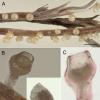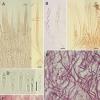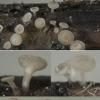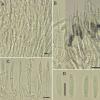
12-01-2026 22:02
Ethan CrensonHello all, I am hoping someone will have some ins

11-01-2026 20:35
Hello.A very tiny pyrenomycete sprouting sparsely

12-01-2026 05:24
 Danny Newman
Danny Newman
Cyathicula coronata on Urtica dioicaCataloochee Di

15-12-2025 11:49
 Danny Newman
Danny Newman
ITS sequences from the following two collections B

09-01-2026 17:41
Arnold BüschlenHallo, F. dilatata wird von vielen Bryoparasiten

10-01-2026 20:00
Tom SchrierHi all,We found picnidia on Protoparmeliopsis mur

07-01-2026 22:22
 Danny Newman
Danny Newman
Tatraea sp. on indet. hardwood The Swag, Great Sm

10-01-2026 01:18
 Danny Newman
Danny Newman
cf. Neovaginatispora fuckelii on indet. shrub Pre

07-01-2026 10:24
 Danny Newman
Danny Newman
Pezicula sp. on indet. hardwood Appalachian Highl

09-01-2026 10:08
 Blasco Rafael
Blasco Rafael
Hola, en el mismo habitat que la anteriorRetamaDia
There are two close species which are going to be send to Danny Halewartes soon for detailed study, but i also wanted to show them here.
Plus I am sending to him these taxonomically related earlier posted samples:
Cyathicula starbaeckii http://www.ascofrance.fr/search_forum/22273
Crocicreas gramineum http://www.ascofrance.fr/search_forum/22254
The first species is close by macro-morphology to Stamnaria persoonii, but has spores more cylindrical, paraphyses of two types and its host is different (E. sylvaticum).
Stamnaria sp., Kh-3519, 09.06.2012, 61,070617N 69,468112E, Russia, Khanty-Mansiyskyi avtonomniy okrug, Khanty-Mansiysk, Shapsha village, Coniferous mixed forest. On litter of Equisetum sylvaticum.
Apothecia turbinate, stipitate, 0.4-0.6 mm in diameter in mature state, 0.5-0.7 mm height; yellow with whitish collar and translucent stem when alive, becoming light brown on drying; when dry collar closes the hymenium making flat crest; scattered abundantly on branches of Equisetum sylvaticum.
Outer layer of apothecium made by gelatinose loosely more or less parallel hyphae, septate, 2-3 mk broad; inner layer of excipulum made from textura prismatica, cells of middle flanks near 30 x 10 mk, shorter to the edge; medulla well developed from wide segmented hyphae, cells near 50 x 7 mk; subhymenium well developed, from intricate hyphae; raising under the hymenium part (collar) has inner layer made from similar to gelatinose narrow hyphae, free upper part of these hyphae covered by warts (outgrowths).
Asci cylindrical, ascus development starts from crozier, barely seen in mature asci, with apical thickening, with euamyloid ring of "Calycina-type", †98 x 9 (90-110 x 8-10.5) mk (measured in dead state); paraphyses of two types; first type of lanceolate paraphyses exceed asci for 30-40 mk, segmented in lower part, lanceolate in upper part with quite acute tip, vacuolar content in vital state not observed, †100-130 mk long and 3-6 mk broad in lanceolate part; second type of cylindrical paraphyses more abundant, not exceed the asci, †80-100 mk long and about 2 mk broad, segmented, cylindrical with obtuse tip, rarely branched and scarcely some enlarged in upper segment; spores fusiform, slightly heteropolar, with obtuse ends, guttulate (but character of guttulae not observed in vital state), †22 x 4.2 (19.4-23.6 x 3.8-4.6) mk, n=20, Q=5.3.
Kh-3616, 26.06.2012, 61,090478N 69,48028E, Russia, Khanty-Mansiyskyi avtonomniy okrug, Khanty-Mansiysk, Shapsha village, Transition between conifer forest at terrace and floodplain, rare flooded level. Community of Epilobium angustifolium, Lamium album, Urtica dioica, Anemonidium dichotomum (most dominated first). On litter of Epilobium angustifolium ssp. macrophyllum.
Apothecia near 1mm high, 800mk diam, long stipitate, disc from deep cupulate to flat disc and enverted, surface smooth outside, with short ciliate (20 mk) row at the edge, watery-whitish all over.
Excipulum textura oblita (cells with thick walls), at stem narrow straight cells (30x3 mk), at disc shorter, more swollen (20x5 mk), some curved, at the edge again thin hyphae, their free ends forming "hairs" 50mk long (hairs filled with many oil droplets); asci *60x6 mk, obtuse-conical; paraphyses the same length, 2 mk thick, cylindrical or some enlarged at top, some filled with oil granules; spores fusoid, *10x2 mk.

Yes for the second sample, C. cyathoidea at least in a wide sense. How did you keep it alive over the years? ;-)
The paraphysis content is not oil but vacuoles, and every living paraphysis has it.
About your first sample here, it did not survive, regrettably. It really looks like a Stamnaria, but the very atypical paraphyses remind me of Crocicreas too, also the apical ring. We will see, hopefully.
Zotto
These photos were done at the time of collection, for C. cyathoideum i was already informed about importance of vital characters, but for Stamnaria sp. unfortunatelly not. Right, i missed to correct evenly old description of Crocicreas where terms used uncorectly (oils/vacuoles).
Probably i will be successful in cultivation of Stamnaria from the substrate (i dig some from the snow in the same place) to observe its vital characters. Otherwise, i will check again this place in June.
Nina.



